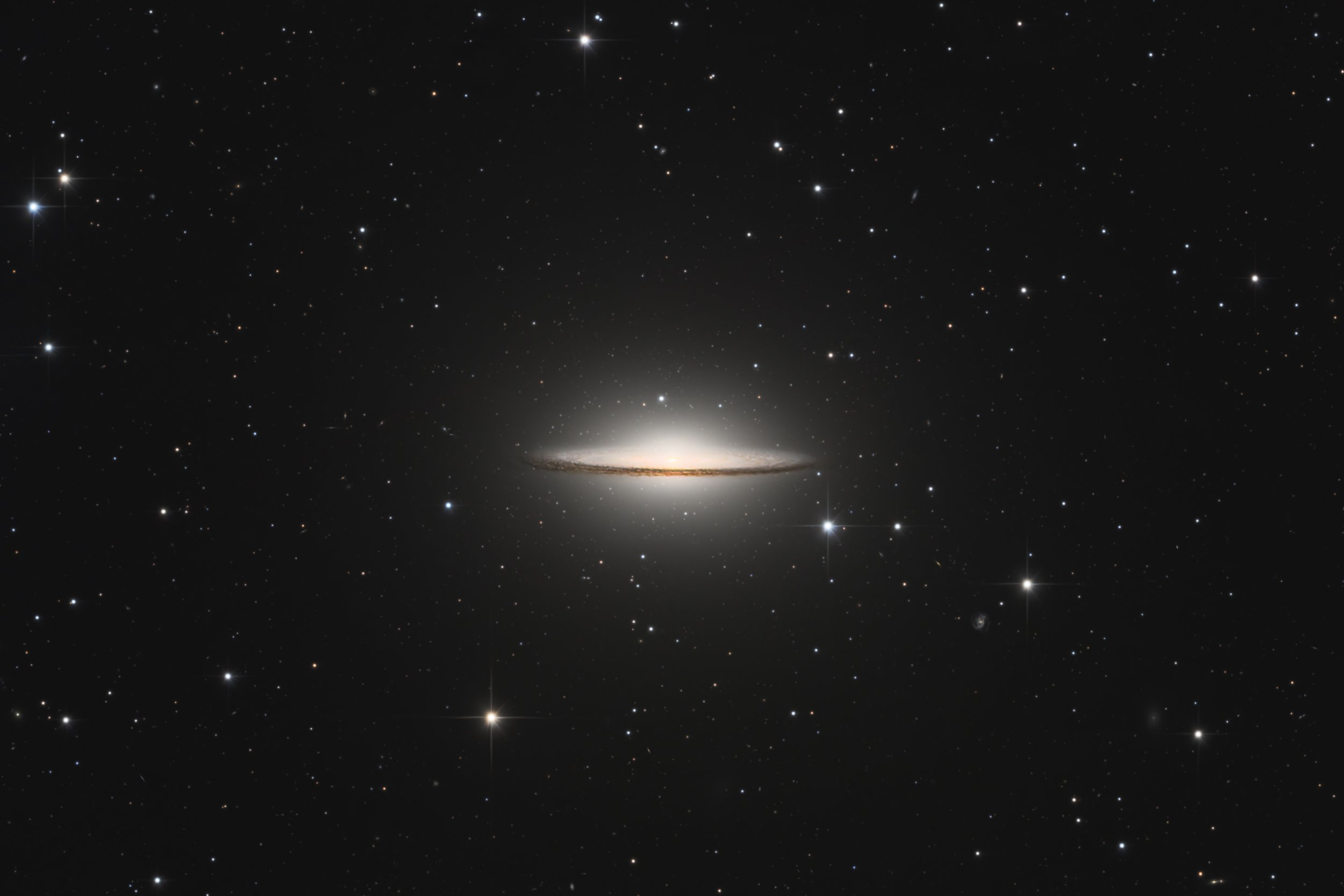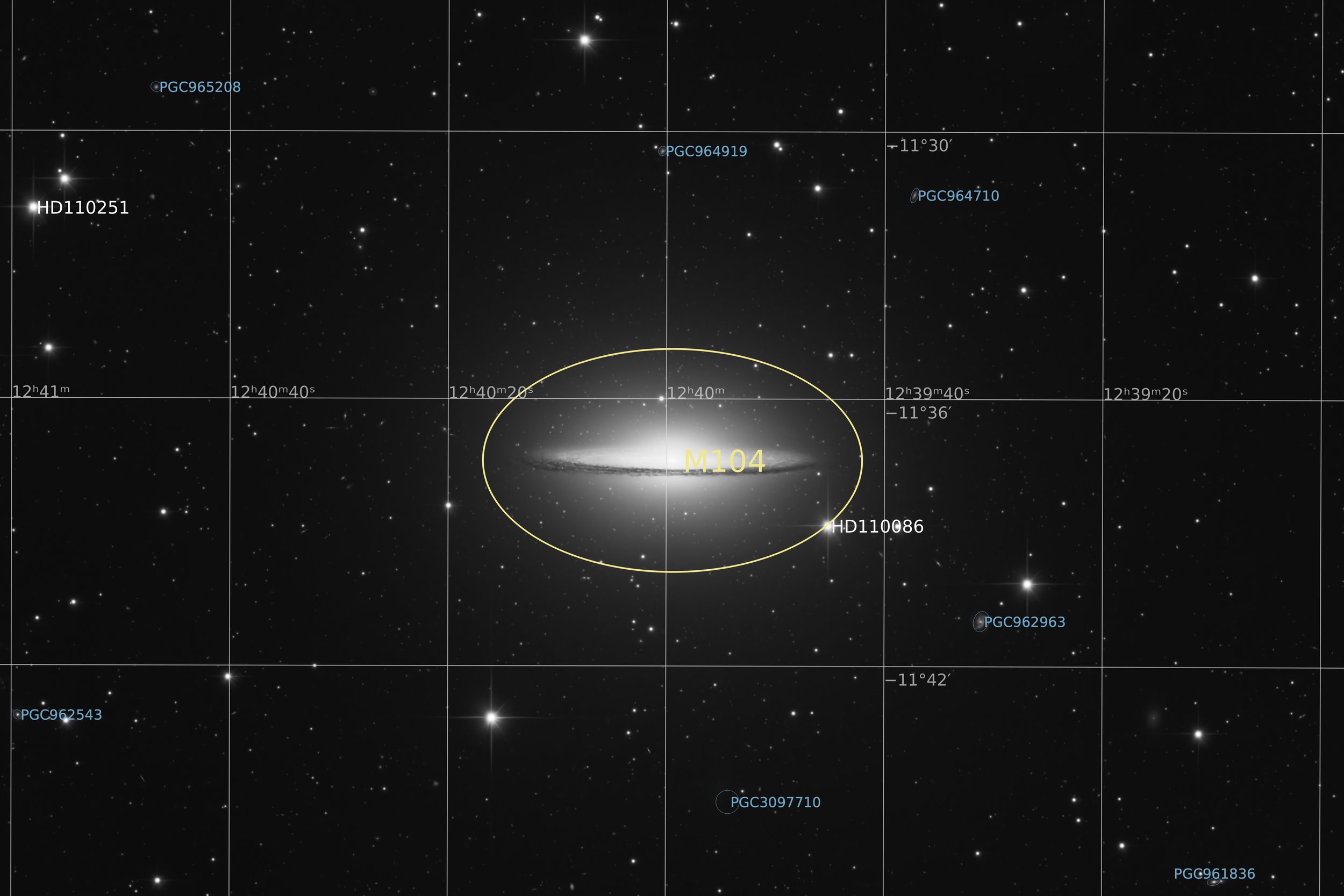M104
NGC 64594, Sombrero Galaxy
30’ x 20’ | 0.3”/px | 6000 × 4000 px | full resolution
Virgo
RA 12h 39m Dec -11° 37’ | 0°



Messier 104, also known as the Sombrero Galaxy, is a peculiar galaxy of unclear classification in the constellation borders of Virgo and Corvus, being about 31.1 million light-years) from the Milky Way galaxy. It is a member of the Virgo II Groups, a series of galaxies and galaxy clusters strung out from the southern edge of the Virgo Supercluster. It has a diameter of approximately 94,900 to 105,000 light-years, making it slightly bigger in size than the Milky Way. It has a bright nucleus, an unusually large central bulge, and a prominent dust lane in its outer disk, which from Earth is viewed almost edge-on. The dark dust lane and the bulge give it the appearance of a sombrero hat (thus the name). The Sombrero Galaxy was discovered on May 11, 1781 by Pierre Méchain, who described the object in a May 1783 letter to J. Bernoulli that was later published in the Berliner Astronomisches Jahrbuch. Charles Messier made a handwritten note about this and five other objects (now collectively recognized as M104 – M109) to his personal list of objects now known as the Messier Catalogue, but it was not "officially" included until 1921. William Herschel independently discovered the object in 1784 and additionally noted the presence of a "dark stratum" in the galaxy's disc, what is now called a dust lane. In the 1990s, a research group led by John Kormendy demonstrated that a supermassive black hole is present within the Sombrero Galaxy. The group showed that the speed of revolution of the stars within the center of the galaxy could not be maintained unless a mass 1 billion times that of the Sun, 109 M☉, is present in the center. This is among the most massive black holes measured in any nearby galaxy, and is the nearest billion-solar-mass black hole to Earth. The Sombrero Galaxy has a relatively large number of globular clusters, observational studies of which have produced population estimates in the range of 1,200 to 2,000. The ratio of globular clusters to the galaxy's total luminosity is high compared to the Milky Way and similar galaxies with small bulges, but comparable to other galaxies with large bulges. These results have often been used to demonstrate that the number of a galaxy's globular clusters is thought to be related to the size of its bulge.
source: Wikipedia
Data Acquisition
Data was collected over 9 nights during the months of May and June 2025, using a 14” reflector telescope with full-frame camera at the remote observatory in Spain. Data was gathered using standard LRGB filters. The plan was to shoot a few hours more, but conditions in June were not great, and many nights were lost for observations. And when the weather got better, M104 was too low on the horizon at dusk. Rather than wait for a year to shoot the remaining hours, the existing data was processed. A total of approximately 14 hours of data was finally combined to create the final image.
Location Remote hosting facility IC Astronomy in Oria, Spain (37°N 2°W)
Sessions
Frames
Equipment
Telescope
Mount
Camera
Filters
Guiding
Accessoires
Software
Planewave CDK14 (2563mm @ f/7.2), Optec Gemini Rotating focuser
10Micron GM2000HPS, custom pier
Moravian C3-61000 Pro (full frame), cooled to -10 ºC
Chroma 2” LRGB unmounted, Moravian filterwheel L, 7-position
Unguided
Compulab Tensor I-22, Dragonfly, Pegasus Ultimate Powerbox v2
Voyager Advanced, Viking, Mountwizzard4, Astroplanner, PixInsight 1.9.3
Processing
All processing was done in Pixsinsight unless stated otherwise. Default features were enhanced using scripts and tools from RC-Astro, SetiAstro, GraXpert, CosmicPhotons and others. Images were calibrated using 50 Darks, 50 Flats, and 50 Flat-Darks, registered and integrated using WeightedBatchPreProcessing (WBPP). The processing workflow diagram below outlines the steps taken to create the final image.
I make a lot of use of automatic stretching algorithms such as SmartStretch (Cosmic Photons) and Statistical Stretch (Seti Astro). But stretching the luminance of galaxies like this with a very bright nucleus and quite some detail in the outer regions often requires a more careful manual approach. Usually a combination of multiple careful steps using GHS and HT work well. That’s what was used for this image. An alternative to blend in small amounts of an HDR-stretched image also works, but bears the risk of bringing a bit of a grey haze over it, that then is more difficult to remove.
The rest of the processing followed largely a standard processing workflow as is shown below.
Processing workflow (click to enlarge)
This image has been published on Astrobin and received Top Pick Nomination status.
